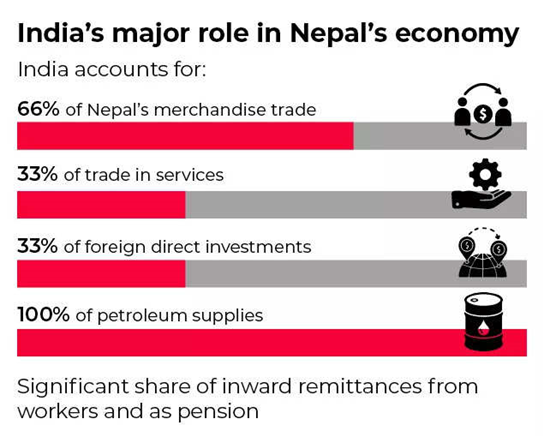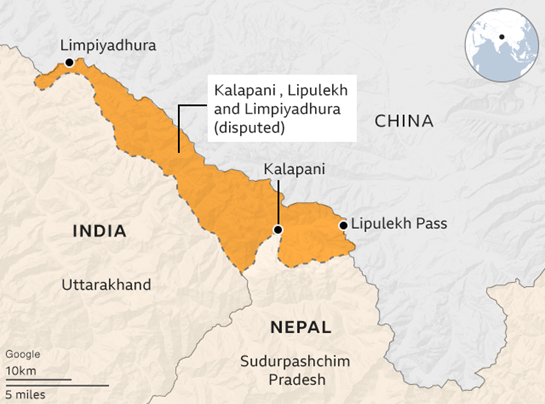NEPAL AND INDIA’S SPECIAL RELATIONSHIP – AND HOW IT IS GETTING BETTER
Relevance: GS 2 – Bilateral, regional and global groupings and agreements involving India and/or affecting India’s interests.
Why in the News?
- India and Nepal share a deep, broad, and wide-ranging relationship.
- Various concerns of the people in both countries need to be addressed.
- The recent momentum in partnership and progress between India and Nepal should be maintained.
- This discussion highlights the importance of sustaining this momentum for future cooperation and development.
Unique Relationship between the two countries
Nepal and India share a unique relationship characterized by:
- An open border
- Shared cultural ties
- Economic interdependence
- Deep-rooted people-to-people connections
- Strengthened Partnership
- The newly-focused partnership has enabled relations to move from strength to strength over the last two years.
- Eight high-level visits, including four by prime ministers, have re-energized relations.
- Many agreements are being implemented.
- Collaborative Efforts Between Nepal and India:
- Reducing the trade deficit
- Initiating and strengthening cross-border digital financial connectivity to facilitate trade, tourism, and remittance flows
- Enhancing physical connectivity to reduce the cost of doing business and promote people-to-people ties.
Nepal’s Ties with India
- Economic Ties: India is Nepal’s largest trading partner, primary source of tourists, sole supplier of petroleum products, and the biggest provider of foreign investment.
- India provides transit for nearly all of Nepal’s third-country trade.
- A significant portion of inward remittances to Nepal comes from pensioners, professionals, and laborers working in India.
- Issues:
- But Nepal’s trade deficit with India is close to 18% of its GDP.
- Inadequate infrastructure and high transaction costs make Nepal a high-cost economy.
- Disaster Response and Support: India has consistently been the first responder during disasters and emergencies in Nepal.
- India provided a financial package of $75 million for the development of areas affected by recent earthquakes in Nepal, alongside immediate rescue and relief efforts.
Electricity Cooperation
- A Joint Vision Statement on Power Sector Cooperation was signed in 2022, covering bilateral cooperation in the production, transmission, and cross-border trading of hydropower.
- The export of electricity from Nepal to India reached around 650 MW in 2023.
- Nepal earned more than Rs 10 billion from electricity exports, helping to reduce the trade deficit and augment foreign exchange earnings.
- The volume of exports is expected to increase significantly.
- Long-term Power Trade Agreement
- In 2023, a long-term power trade agreement was signed to export 10,000 megawatts of electricity from Nepal to India over 10 years.
- This agreement is essential for boosting investor confidence in Nepal’s hydro sector and ensuring returns on their investment.
Hydroelectricity Export and Regional Cooperation
- Significant partnerships have been formed to build cross-border transmission lines.
- Nepal has started exporting hydroelectricity to Bangladesh under a tripartite agreement with India and Bangladesh.
- Nepal plans to export 40 MW of electricity to Bangladesh in 2025, with potential increases in the future.
- New avenues have opened for a regional grid in the BIMSTEC and SAARC regions to promote, develop, and trade renewable energy, a priority for member countries.
Digital Financial Connectivity
- Nepal and India decided to establish and enhance digital financial connectivity.
- Indians traveling to Nepal can now make payments through their mobile phones.
- Nepali people will soon be able to do the same after the Nepal government finalizes regulations.
- This facility will enable hassle-free payments for traders, tourists, pilgrims, students, and people traveling to India for medical treatment.
- The mobile transfer mechanism will allow workers in Nepal and India to transfer earnings through formal channels to their home countries.
Measures that Deepened and Enhanced the Relationship
- The momentum of partnership and progress in recent years must be continued.
- Bilateral Mechanisms
- Established bilateral mechanisms to address areas of cooperation and concerns, including boundary issues, should be activated to keep the relationship robust.
- Banking and Identification Simplification
- Requirements for Nepalis to open bank accounts in India are being simplified.
- The process for Nepali residents to obtain an Aadhaar card is straightforward.
- Petroleum Pipelines:
- Construction of two new petroleum pipelines between Siliguri, India, and Jhapa, Nepal, and between Amlekhgunj and Chitwan is underway.
- These projects follow the success of the Motihari-Amlekhgunj petroleum pipeline, inaugurated in 2019, the first-ever cross-border pipeline in South Asia.
- The Motihari-Amlekhgunj pipeline has saved Nepal at least Rs 1 billion per annum in transportation costs.
- Additional savings come from reduced pilferage, leakage, theft, and delays by using pipelines instead of trucks.
- Integrated Check Posts (ICPs): Two additional ICPs will be built in Bhairahaba and Dodhara-Chandani, Nepal, with grant assistance from India to facilitate the smooth movement of cargo and passenger vehicles.
- Three ICPs have already been completed.
- Transportation Infrastructure:
- Border roads have been upgraded to reduce transportation and transaction costs.
- Cross-border freight rail between India and Nepal is operational, with several other cross-border roads and bridges under construction.
- The feasibility study of the Raxaul-Kathmandu railway has been completed.
- A direct rail service from Ayodhya to Janakpur is being considered.
Alternative articles
https://universalinstitutions.com/india-nepal-relations/
Mains question
Discuss the collaborative efforts between India and Nepal in enhancing their bilateral relations, focusing on economic partnerships and energy cooperation. (250 words)






